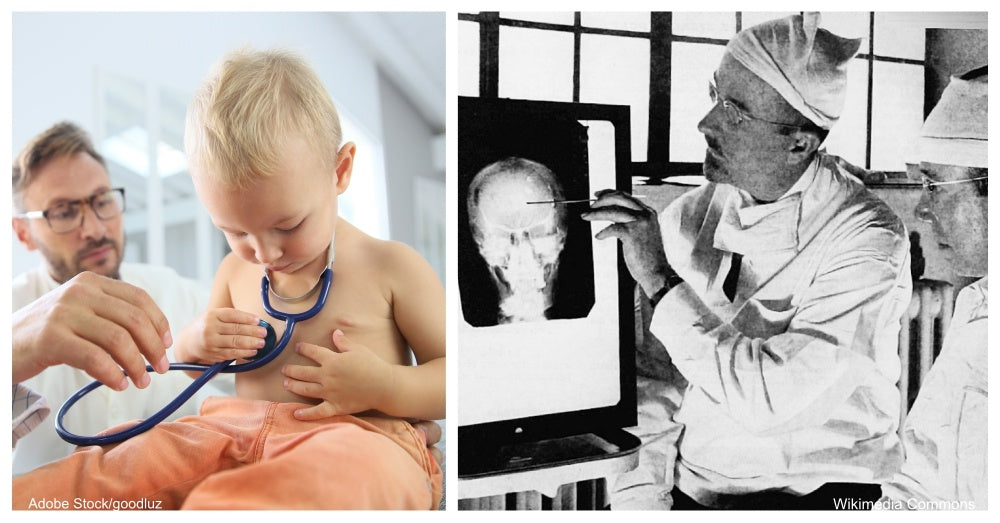8 Weird and Awful Ways People with Autism Have Been 'Treated' Throughout History
Shopify API
Autism has been misunderstood for years, and with this misunderstanding has come some bizarre and even cruel treatments. As more knowledge and comprehension of the condition has developed, so have treatments — for the most part. Some of the more unusual approaches that were used to treat autism still persist today, which is both surprising and unsettling, and indicative that more knowledge of autism is needed. Here's a look at some of the autism "treatment" methods that have been used throughout history.
8. Biochemical Treatments
Beginning in the 1920s, roughly a decade after Swiss psychiatrist Eugen Bleuler first uses the term "autism," biochemical treatments were introduced that targeted the diet of a child with autism. Doctors theorized that certain elements of a child's diet, such as gluten, worsened the symptoms of autism. Therefore, gluten and casein were removed from their diets in an attempt to relieve symptoms. Studies are still being conducted today, with one 2006 study suggesting the subjects saw improvements, though much of the evidence that has been presented has been anecdotal.
 Photo: Flickr/Beckmann's Bakery
Photo: Flickr/Beckmann's Bakery
7. Aversive Punishment
Beginning in the 1970s, electric shock therapy was used to treat autism as a way of "aversive punishment." Scientists believed that punishing children with an electric shock when they engaged in an unwanted autistic behavior would cure them, with one article reporting "many positive outcomes." Backers claimed this type of treatment led to improved social behavior. These treatments are still used in some cases today.
 Photo: Wikimedia Commons/Rodw
Photo: Wikimedia Commons/Rodw
6. Parentectomy
One of the most bizarre treatments, and possibly most mentally and emotionally harmful, was parentectomy. This 1950s treatment was based on the "refrigerator mother theory," which proposed that autism was caused by cold, uncaring mothers. Psychoanalyst Bruno Bettelheim subscribed to this theory, which led to parentectomy treatments, or the removal of the child from their parents for long periods of time. Bettelheim was later found to be a fraud who lied about his credentials and whose findings have been discredited. Although the theory has become widely rejected, there are still some psychoanalytic therapists who continue to support these ideals.
 Photo: Pixabay
Photo: Pixabay
5. LSD
Another peculiar treatment that was instituted in the 1960s was the use of LSD, a serotonin inhibitor, to alleviate symptoms of autism. Children were given doses of the perception-altering hallucinogenic drug with the belief that altering their state of perception would lead to reduced symptoms, and maybe even a cure. One study reported that after being given the drug, subjects became happier and were in an improved mood. The treatment was very controversial, received much criticism, and was discontinued.
 Photo: Flickr/Nikole Handel
Photo: Flickr/Nikole Handel
4. Holding Therapy
Holding therapy is a form of treatment that was developed in the 1990s. It introduced forced holding of its autistic subjects, as well as forced eye contact, as a method of "fixing" some of the behaviors related to autism. This type of therapy can actually be dangerous and traumatizing for children dealing with autism. Critics contend that there is no empirical evidence to support the theory behind this therapy.
 Photo: Pixabay
Photo: Pixabay
3. Miracle Mineral Solution
Miracle Mineral Solution is a product that is promoted as a cure to several diseases and conditions, including autism. The treatment specifies that a child be given the solution orally or via enema daily. The solution, which contains, sodium chlorite in distilled water, has been compared to being on par with industrial-strength bleach. Despite no clinical trials to support the product claims, it is available for purchase online, and it has even been promoted at the Autism One conference.
 Photo: Pixabay
Photo: Pixabay
2. Hyperbaric Oxygen Treatment
Hyperbaric oxygen chambers are basically units containing pressurized oxygen that increase oxygen levels in the body. This treatment is used to treat a plethora of health problems from PTSD to gut inflammation. It's also being used to help relieve symptoms related to autism because it allows oxygen to get to areas of the body that are possibly lacking, such as parts of the brain, to allow for healing to occur. There is still much to be learned about this form of treatment.
 Photo: Pixabay
Photo: Pixabay
1. Lupron Therapy
Lupron was touted as a miracle drug by the physicians who developed the treatment featuring its use. Dr. Mark Geier based this therapy on the idea that autism is caused by a mercury and testosterone link that Lupron supposedly fixes. However, the ideas around Lupron therapy weren't based in proven science and drew much criticism from mainstream medicine experts. The drug has also been used to treat prostate cancer in men, to treat endometriosis in women, and to chemically castrate sex offenders. The impact of its use is unknown, and experts warned it could lead to potentially serious side effects. Geier was later stripped of his medical licenses, while his partner and son, David, was charged with practicing medicine without a license.
 Photo: Pixabay
Photo: Pixabay
While some of these bizarre treatments and therapies still exist, they are fortunately not as prevalent. And yet, despite the advancements made in the medical field, more learning and research is necessary, as the need for more knowledge and acceptance of those dealing with autism continues to remain.

